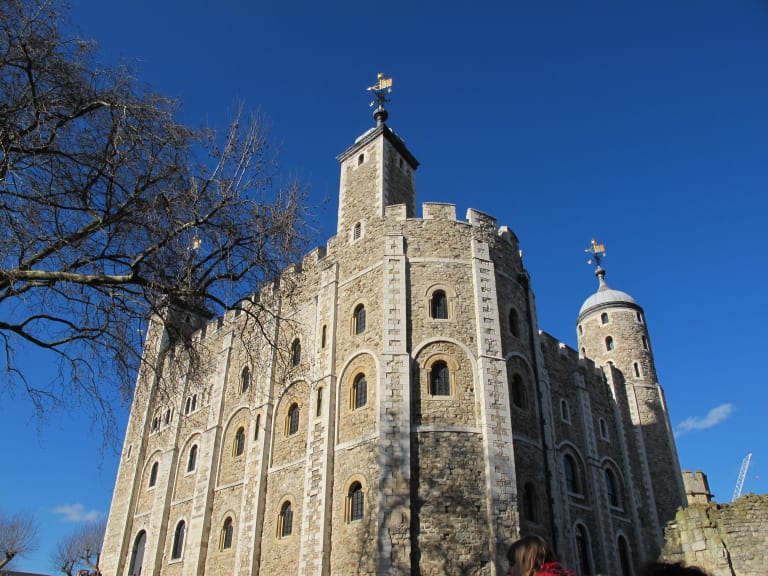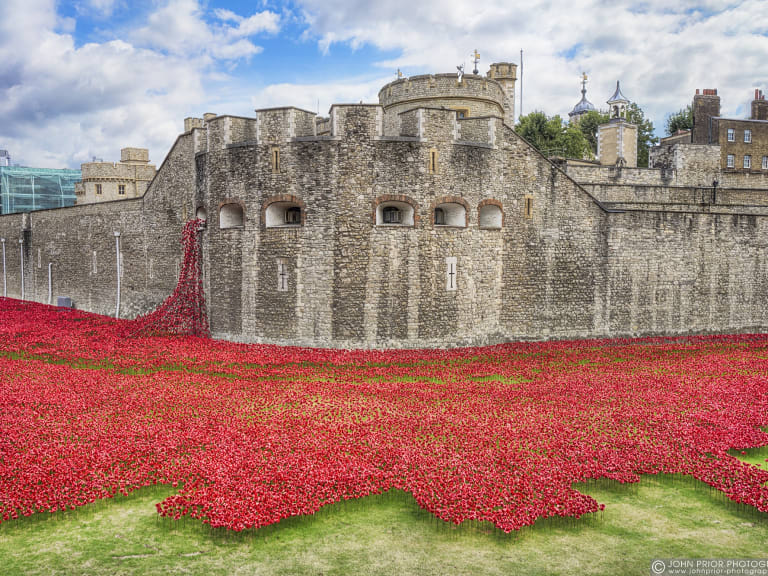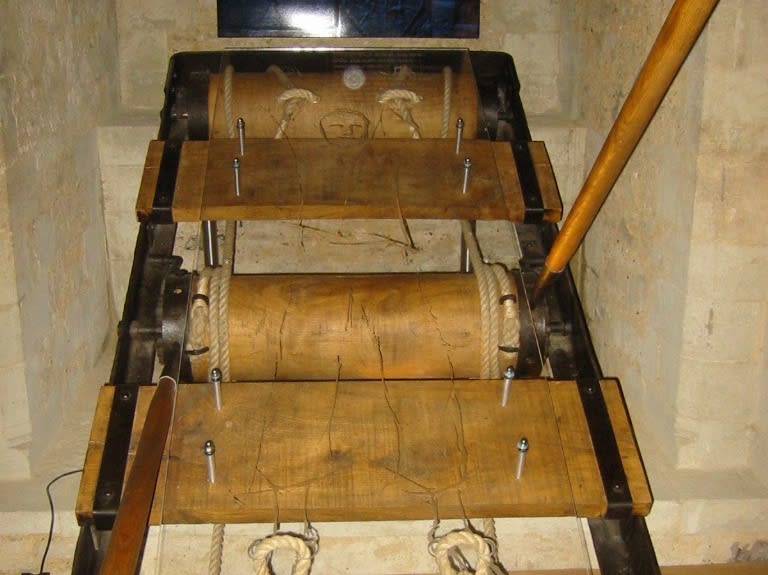More about: 10 Things You Can´t Miss at the Tower of London
Located on the banks of the River Thames, the Tower of London is one of the most popular tourist attractions in the city because of the mixture of intrigue and fear that its history inspires.
There is no doubt that it is one of the essential places to see in London during your trip. It has also been a UNESCO World Heritage Site since 1988. If you want to know everything you can see in the Tower of London, I recommend you to read this post and get your tickets to the Tower of London in advance, so you don't get caught out.
1. The Crown Jewels

During your visit to the Tower of London you will have the opportunity to see the Crown Jewels of the British monarchy, magnificent pieces of precious metalwork.
As well as the jewellery that Queen Elizabeth II of England usually wore in her public appearances, you can also see insignia, crowns, swords, sceptres and other objects of great value that are used in different events and ceremonial acts, such as:
- St Edward's crown: the most important in the royal collection and the one used to crown monarchs in Westminster Abbey.
- The Imperial Crown of State: this was made for the coronation of Queen Victoria and is used for the opening ceremony of the British Parliament.
- The Sceptre of the Dove and the Sceptre of the Cross: held by the monarch at the moment of her coronation.
- The jewelled sword of the Offering: created for the coronation of George IV, it is also used at the coronation ceremony of kings.
2. The White Tower

The White Tower is an iconic London landmark that has stood for almost a millennium. It stands in the centre of the Inner Ward and has served as a royal residence, prison and armoury over the years. It is so called because of the white stone used in its construction, which gives it its beautiful gleaming appearance.
Inside the White Tower you can see two very interesting places:
- Line of Kings: one of the earliest exhibits in the world. It dates back to the 17th century and King Charles II presented this collection of weaponry to the public in order to promote his newly established monarchy after the English Revolution.
- St John's Chapel: located on the first floor of the White Tower. It was built in the late 11th century for the use of the royal family while they lived in the fortress. It is a beautiful example of Norman church architecture.
3. The Fortress

The Tower of London was built by King William the Conqueror in the 10th century to protect London and to watch over shipping traffic on the River Thames. Its reputation as a fortress remains unchanged, as it was besieged several times but never taken.
During your visit to the Tower of London you can learn about its fortress side, explore its impregnable defences and imagine what it was like to be a soldier in those days on a mission to defend this most important bastion.
Don't be surprised if you see soldiers guarding the Queen 's House or Jewel House. You may even come across the famous Beefeaters who have guarded this place with great zeal since Tudor times and who now give guided tours of the Tower of London.
4. The Medieval Palace

During your visit to the Tower of London you will enter the chambers of two English kings, Henry III and Edward I, who in the 13th century expanded the fortress defences and built a luxurious new palace inside.
The Medieval Palace consists of Wakefield Tower, St Thomas' Tower and Lanthorn Tower. Inside you can see fantastic recreations of the rooms where the monarchs lived during their visits.
For example, in St Thomas's Tower you can see a recreation of the bedroom of King Edward I with a small chapel. But where I advise you to open your eyes wide is in the Lanthorn Tower, where a very curious collection of rare objects dating from medieval times is on display.
5. The Green Tower

As well as being a royal residence and fortress, the Tower of London was also used as a prison and scaffold for the execution of those convicted of treason and other crimes.
This is one of the most chilling parts of the visit because during the tour you can follow in the footsteps of those condemned to death there.
Death in the Green Tower (located to the west of the White Tower) was a "privilege" reserved for those of high rank or those who had great popular support and could not be executed in front of the crowds. Some of the people who perished here were:
- Anne Boleyn
- Catherine Howard
- Queen Jane Grey
6. The Queen's House

On one side of the Green Tower you'll find The Queen's House, a half-timbered cottage best known as the place where Queen Anne Boleyn spent her last days before her execution.
However, you may also be surprised to learn that this was the site of the trial of Guy Fawkes, a Catholic revolutionary who took part in the Gunpowder Plot of 1605 to kill King James I, who refused to grant some religious toleration to Catholics in the kingdom.
7. The Bloody Tower

The name will give you a clue that this was one of the least recommended places to be in the Tower of London.
It is called the Bloody Tower because it is associated with the disappearance and presumed death of the infant King Edward V and his younger brother Richard in 1483. Both were confined here on the orders of their uncle, the future King Richard III, and some time later mysteriously disappeared, leaving him with a clear path to the throne.
Another of the most famous prisoners imprisoned in the Bloody Tower was Sir Walter Raleigh, Queen Elizabeth I of England's favourite privateer to attack the Spanish Empire before her fall from grace. You can see his cell as it was during his multiple imprisonments here before his execution for treason.
8. Exhibition on torture at the Tower of London

Another of the most sinister parts of a visit to the Tower of London, along with the Bloody Tower or the Green Tower, is the exhibition on torture in Lower Wakefield Tower.
The period between the 16th and 17th century was a time of extreme religious and political turmoil in England, which resulted in a multitude of executions and torture for its inhabitants.
There is evidence that almost 50 people suffered physical and mental torment in the Tower of London for practising Catholicism, to force them to confess to deeds or inform on others before being taken to the scaffold. In this exhibition you can see some of the elements of torture that were used in the Tower
Isabel's Traveler Tip
This exhibition will make your hair stand on end, so if you visit the Tower of London with children or if you are a sensitive person, it is best to avoid it to avoid having nightmares.
9. The Crows at the Tower of London

The Tower of London's most famous inhabitants are its beautiful black crows. Did you know that a legend has been circulating since the time of King Charles II that if these crows were to disappear from the Tower of London, it would collapse and the whole kingdom with it?
The English take this superstition very seriously and make sure that there are at least seven crows roaming the grounds. So if you pay a visit to the Tower of London, you're bound to see them. However, they also take some extra precautions and therefore clip the birds' wings so they can't wander off.
In any case, the crows at the Tower of London are very well cared for and fed by a Ravenmaster and in recent times there have even been several crow chicks born here as part of the breeding programme at the Tower of London.
10. Tower of London Menagerie

Did you know that there used to be a menagerie in the Tower of London? They were there from the 13th century until the 19th century, when they were moved to Regent's Park Zoo.
The function of the menagerie was not only to entertain the royal family and their guests by watching exotic animals (there was even a polar bear!) but also to guard the Tower of London itself. The animals were therefore placed in strategic locations near the middle tower and the moat.
Today you can see some sculptures depicting those wild animals (which the famous "Beefeaters" were in charge of) and the spaces they occupied.




